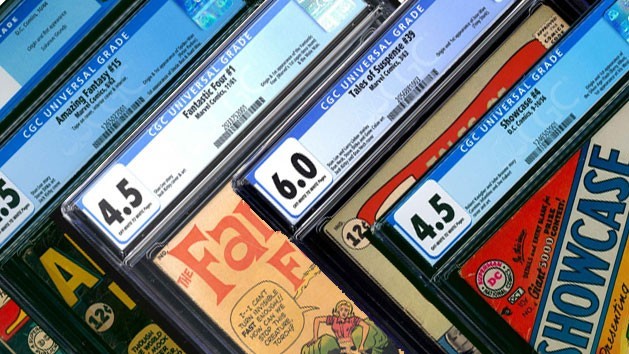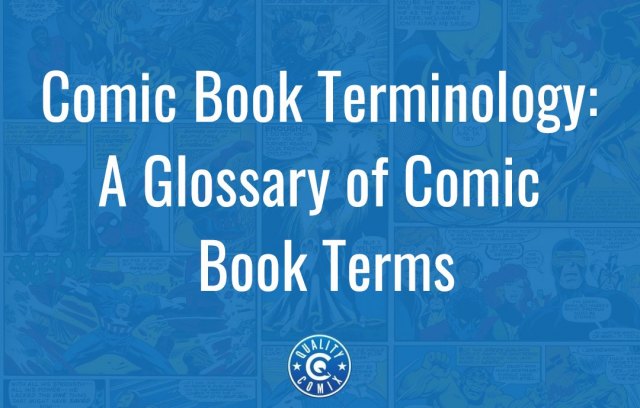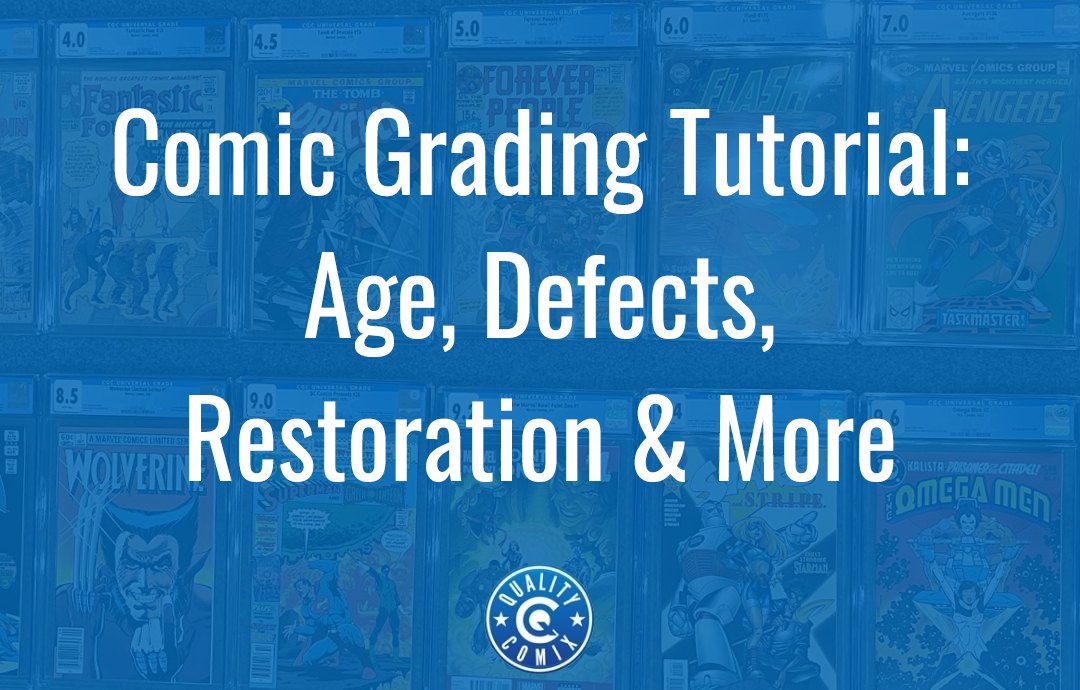
Grading comics is somewhere between an art and a science. After seeing thousands of comics from many different eras, you can start to notice patterns in damage, wear, restoration, and other details that can affect the grade of a book. This experience allows us to estimate the rough grade a comic may have, though, of course, the officials at CGC or your grading company of choice may differ.
Grading is objective within certain bounds. Different kinds of damage, restoration, and quirks of condition will affect a grade in different ways and to differing degrees. It's within these condition zones that subjectivity comes into play. How much wear, how much of a tear, how much damage is considered minor versus major? Someone has to draw the line, and it's not like there's a computer using mathematical analysis to apply the same standard across the board.
This is why two comics with very similar degrees of wear can have slightly different grades (think 9.8 versus 9.6) and why different companies and different individuals within a company will generally offer different grades. A book graded at a 6.0 is going to be around a 6.0 no matter who does it, but when you're looking at high-grade, tenth-of-a-point differences, the variation can be impactful.
Remember, the difference between a few decimal points can be hundreds or thousands of dollars for rare, sought-after comics. It's important to have a clear idea of what you have!
Below, we're going to go over the common kinds of damage and issues we see with comics of various eras, as well as the average grades you're likely to get for different books. For a direct comparison of how different kinds of damage impact a book, check out this video:
https://www.youtube.com/watch?v=Mxfs0AY0EnI
Table of Contents
The Grading Process: What We Look For and How We Check
We aren't CGC, but we're fans and experts in comics, and we've developed a process to examine and offer a grade on a comic.
The process starts by looking at the book at arm's length. A surface-level examination can give you an immediate impression of the kind of grade it's likely to receive. After all, once a comic is encapsulated in a slab, this is the kind of impression you'll get; damage to the inside can and will affect the grade, but visible damage to the covers can be even more impactful.
In particular, we examine the front cover and look for various kinds of damage. These can be anything from tears, cuts, and creases to wear around the edges, scratches and abrasions, dirt, and markings.
- Note: not all markings are necessarily bad. An authorized signature can increase the value of a book (though an unauthorized signature might not if it can't be verified). For a prime example of non-signature markings, you can see the "Red Rocket" copy of Action Comics #1, which still maintains immense value.
Once the front of the book has been examined, we flip it over and look for similar blemishes on the back. Covers are subject to some of the worst damage a comic can have since they're exposed to the environment; that said, interior pages can be damaged as well. Covers are also checked for how well they still attach to the rest of the book around the staples.
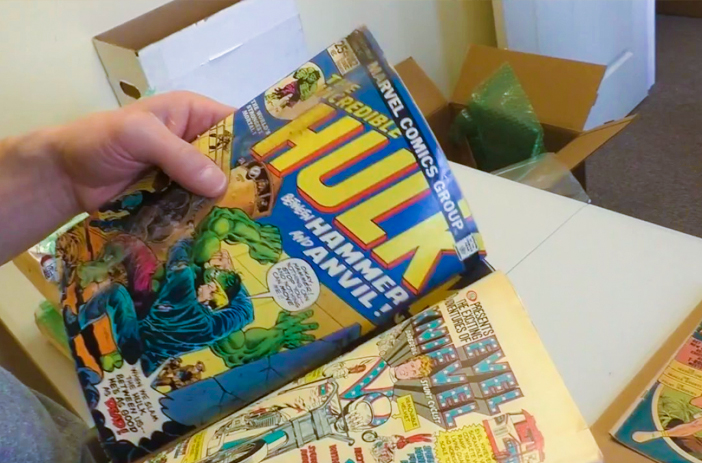
Image source: Google Images
Many comics have a lot of damage simply stemming from the fact that they were read and enjoyed for years (or even decades) before being graded. Remember, while being graded solidifies the monetary value of a comic, the sentimental value can exceed that grade in the hearts of comic fans.
After the examination of the back of the book, the interior is checked. Now, this is a contentious subject. Some people argue that the interior condition of a book isn't as meaningful since a slabbed comic only really shows the covers. Others want a full judgment of the condition of the book, inside and out.
Generally, grading agencies like CGC will examine the interior of the book and will even produce grading notes that mention things like pen marks, creases, tears, and other damage to the inside of the book. However, minor damage and defects to the interior of the book may not affect the grade as much as similar damage to the covers would.
One thing to note is that different eras of comics have different common kinds of damage. Obviously, the older a book is, the more likely there is to be significant damage, which is why the most valuable comics in the world are still only graded at 6.0 and below. Comics were treated as disposable, printed on lower-quality paper and with lower-quality inks, and handled poorly – after all, they were toys for children more than anything else. Few survive, and even fewer survive in any decent condition. Immaculate copies of Golden Age comics are virtually nonexistent.
Let's look at the common kinds of damage you'll see in each era of comics.
Damage to Golden Age Books (1938 – 1956)
Golden age books are by far the most damaged, rarest, and most subject to low grades, with "high" grades in the 4s and 5s. We assume the average is a 2.0 (GD or Good condition) because of the many various kinds of damage common to these books. You are likely to see:
- Missing internal pages.
- Incomplete/torn internal pages.
- Cutouts that have been, well, cut out.
- Brittle paper that chips and deteriorates.
- Staples that have rusted, stained the paper around them, and detached from the rest of the book.
- Sun shadows caused by uneven sun exposure fading certain portions of the ink.
- Grease pencil writing on the cover, as well as price stamps (which don't generally impact grade by a lot).
- Pen or marker writing or store stamps (which do).
Additionally, you can see damage from improper storage, such as foxing, mold, mildew, moisture stains, and wavy paper.
On top of all of this, you'll often see attempts at restoration. Restoration happens for a number of reasons; sometimes, it's an amateur looking to repair a book for their own purposes, sometimes it's an attempt to conserve a rare book, and sometimes it's people who just don't know better. Occasionally, you even see subtle attempts at restoration with the intent of improving the condition of a book to boost its value, usually without disclosing the restoration. Restoration is generally identifiable and is usually considered damage; even if it makes a book more readable, it's not in original condition and thus not as valuable or sought-after.
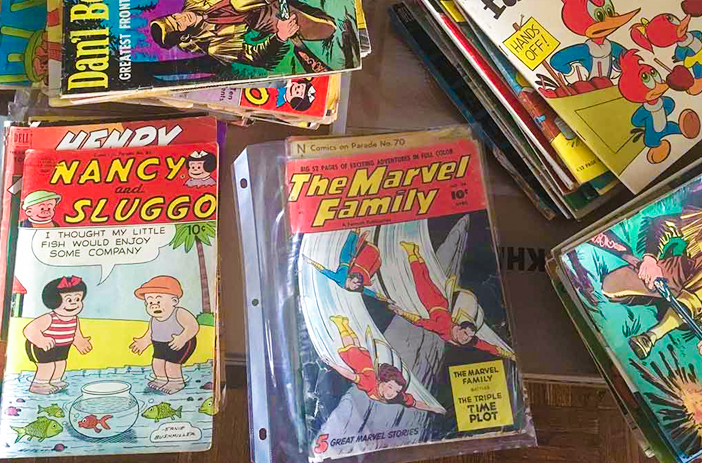
Image source: Google Images
Restoration can look like:
- Glue added to keep parts of the book together, most often seen along the spine in an attempt to keep the cover attached to the rest of the comic.
- Missing pieces of a book added in from other books (or "married" as we call it). This is most common with covers, centerfolds, and pages that are commonly cut out; donor pages from other books are stitched into the original book in an attempt to make it appear more whole.
- Tear seals, which are attempts to repair tears in a book, usually with archival glue, tape, or even a patch from another copy of the comic. These are identifiable on a close inspection. Sometimes, people even have them removed prior to grading these days.
- Color touch-ups. These involve using new/modern inks to try to patch up missing, scuffed, or creased areas where the original color is missing. While it can make the outer appearance of a comic look better, it can also bleed through and stain the interior cover or even interior pages. Think applying sharpie on a standard piece of paper and seeing the ink bleed through to the surface below it.
Some comic collectors believe that restoration is fine – after all, shouldn't making a comic look better and be more whole be a net benefit? – but others argue that the original condition is more important. Currently, prevailing winds push towards no restoration, so restoration decreases the grade of a comic and usually gets it a special label.
One thing to note here is that cleaning and pressing – which don't use destructive means, don't patch in other pieces, and don't use glue, tape, or any other materials – are not generally considered restoration. You can read more about this and the minor controversy surrounding it in our guide to pressing and cleaning.
Damage to Silver-Age Books (1957 – 1969)
Silver Age books are less rare (and less desirable) than Golden Age books. Since they're newer and tended to be printed in higher numbers, there are more copies in better condition than there are of Golden Age books. Though, that's not saying a lot; they're still old, rare, and subject to the ravages of time.
There's also a bit of a divide. We generally assume that books printed between 1957 and 1962 are in worse condition than those printed between 1962 and 1969; the earlier books tend to average around a GD/VG (Good/Very Good) grade of 3.0, and those from the latter half of the era are usually a bit better, a VG 4.0 on average.
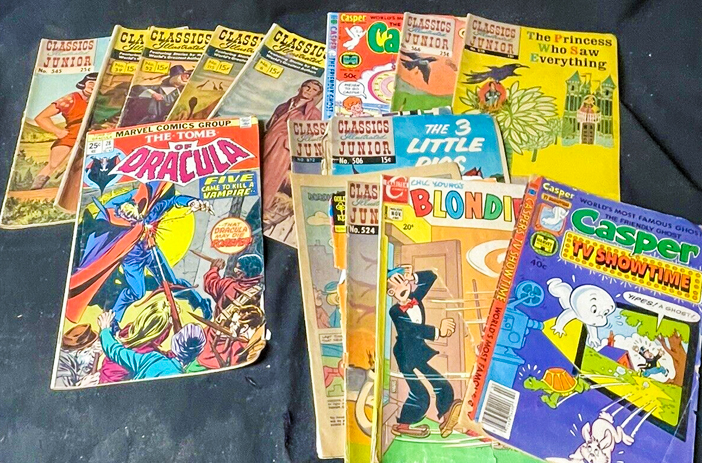
Image source: Google Images
Many of the common defects in comics of this era are similar to those in the Golden Age, but there are a few differences.
- Rubbing, where friction between books stored against each other or books stored against other surfaces, leads to dulled glossiness, loss of color, and surface wear.
- Missing, incomplete comics often have coupons and other bits of pages cut out from mail-in promotions. This was the era just before people started collecting comics in earnest, so damage wasn't considered important to the still-disposable media.
- Storage damage is still common, including foxing, wavy pages, mold, and mildew.
- Spine splits and creasing is still common and always will be in comics that are read more than collected.
- Staple damage and rust, along with detached staples and rust staining, are all common.
- Fingerprints are common in this era. Ink was different back then, and the printing process made it a lot easier for ink to wear off at a touch and, more importantly, transfer to lighter areas of other pages when handled, leaving fingerprints.
- Grease pencil writing on the cover, as well as price stamps (which don't generally impact grade by a lot).
- Pen or marker writing or store stamps (which do).
- There's also the issue of "chipping," also known as "Marvel Chipping," because of how common it was with Marvel books. Chipping occurs when the blades used to cut pages down to size aren't sharp enough. Instead of cutting the paper cleanly, it would leave micro-serrations along the edge. Over time, this damage grows, and bits of the paper chip off. Here's a discussion of chipping.
- Restoration of Silver Age comics still happened fairly frequently, though because of the kinds of errors, it was more often color touch than any other restoration. A skilled eye can detect this on a close inspection.
The tail end of the Silver Age is when comic collecting started to be a concern, and comics started to be saved, though storage wasn't always done well.
Damage to Bronze Age Books (1970 – 1983)
Bronze age books are generally found in better condition for a variety of reasons. They were printed in greater numbers, they were cared for more by people who started collecting rather than just consuming, and the industry matured enough to invest in some better processes. We generally assume a starting point of Fine (6.0) for this era.
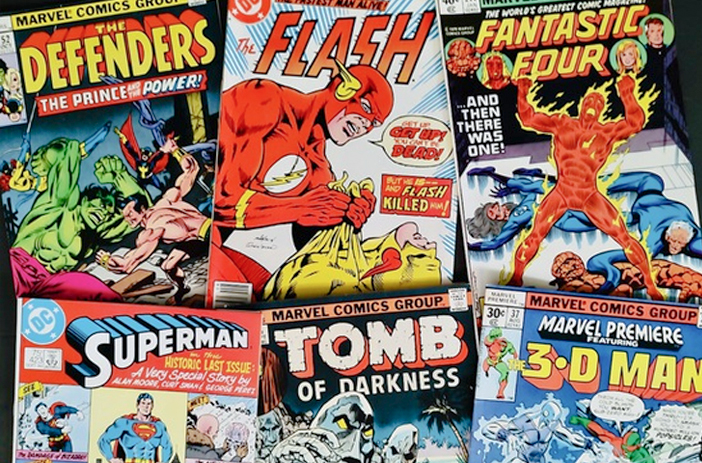
Image source: Google Images
At the same time, some gimmicks like Marvel Value Stamps (which could be cut out and collected in stamp books) came and went in the era, so many Bronze Age comics are missing these stamps. This era also had a lot of rubbing damage since people stored comics but didn't quite know how to protect them properly.
Damage to More Recent Books (1984 – Present)
This is where grades start to kick up. Books from 1984 to 1991 tend to average Very Fine (8.0), while books after 1992 often get 9.0 or more. This is, of course, due to the more recent printings, the greater attention and resources available to collectors, and the higher numbers of comics printed, so higher-condition books are a lot more common.
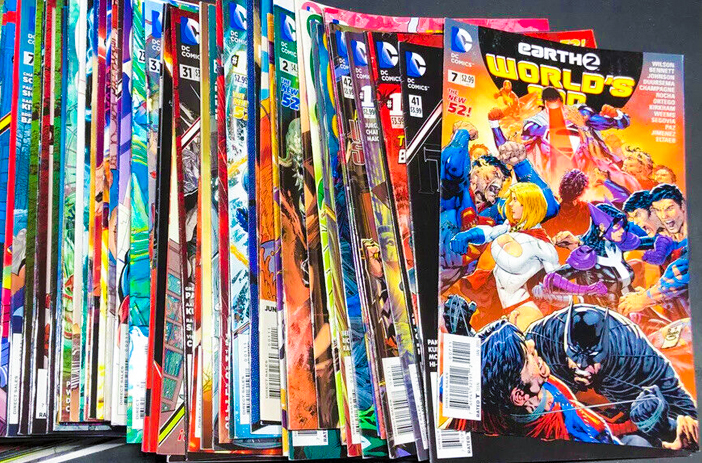
Image source: Google Images
You still see some kinds of damage in this era, usually stemming from a book being read and enjoyed more than collected, a book being stored poorly, or environmental damage. Loss of gloss, miswraps in protective covers (which can sometimes be sought-after by oddity collectors and doesn't often hit the grade too hard), and fingerprints are all common.
Judging Comics of Any Era
If you have comics you'd like to have appraised, we're more than happy to give them a look.
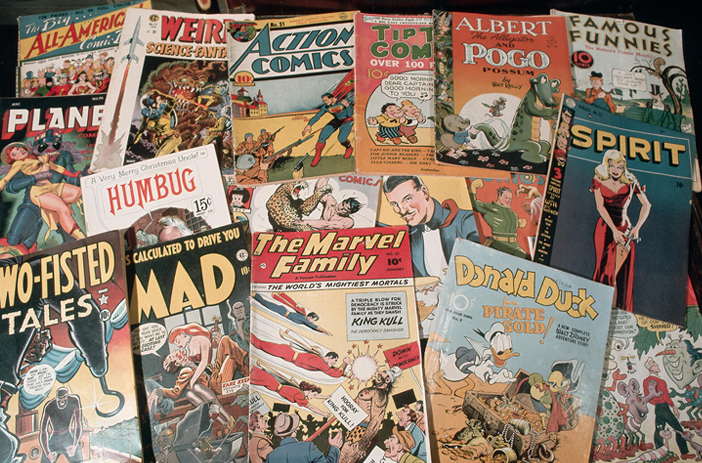
Image source: Google Images
We're not a grading company, but we know a thing or two, and we can help you estimate the condition of what you have, so you can decide what the next steps to take may be. Feel free to reach out for a no-pressure, no-obligation chat at any time!

